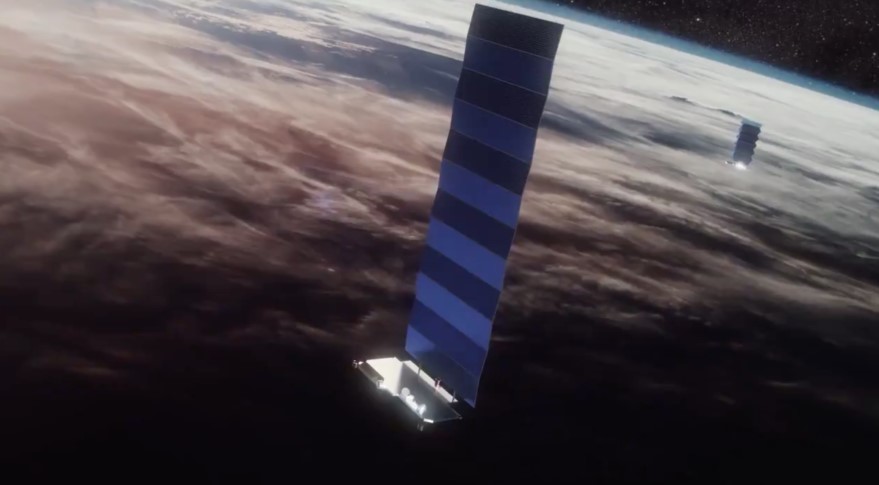Contact Lost With Three Starlink Satellites, Other 57 Healthy

WASHINGTON — Three of the 60 satellites SpaceX launched last month to begin its broadband megaconstellation have lost contact with ground control teams, a SpaceX spokesperson said June 28.
Those three satellites will deorbit "passively," the spokesperson said, meaning Earth's gravity and atmospheric drag will pull them down until they burn up in the atmosphere.
Observers had noticed some Starlink satellites had not initiated orbit raising after being released May 23 from a Falcon 9 upper stage into a 440-kilometer low Earth orbit. SpaceX said May 31 that all 60 satellites were initially responsive.
Related: SpaceX's 60-Satellite Launch Is Just the Beginning for Starlink Megaconstellation Project
SpaceX's spokesperson, in their June 28 statement, said the company will intentionally deorbit two functioning satellites as well, in order to test the spacecraft's ability to propulsively deorbit.
"Three satellites which initially communicated with the ground but are no longer in service, will passively deorbit," the spokesperson said. "Due to their design and low orbital position, all five deorbiting satellites will disintegrate once they enter Earth's atmosphere in support of SpaceX's commitment to a clean space environment."
SpaceX Founder Elon Musk stressed that the early Starlink satellites had a high risk of not working given the quantity of newly developed technology they carry.
Get the Space.com Newsletter
Breaking space news, the latest updates on rocket launches, skywatching events and more!
"It's possible that some of these satellites may not work, and in fact [there's a] small possibility that all of the satellites will not work," he said during a May 15 call with reporters. "But these are a great design and we've done everything we can to maximize probability of success."
SpaceX sought and received approval from the U.S. Federal Communications Commission to operate a portion of its megaconstellation in a 550-kilometer orbit instead of its originally planned 1,150-kilometer altitude. The lower orbit means the satellites will deorbit within five years without propulsion, according to SpaceX.
SpaceX's spokesperson said 45 of the 60 Starlink satellites have reached their target altitude. Another five are in the process of orbit raising, and the last five are completing "check-outs" before also orbit raising, the spokesperson said.
The 60 satellites SpaceX launched in May are not the final design for its constellation of up to 12,000 satellites. The satellites lack inter-satellite links expected for future generations, and have some dissimilar features so that the company can test different technologies.
"SpaceX implemented slight variations across the 60 satellites in order to maximize operational capability across the fleet," the spokesperson said. "While we are pleased with the performance of the satellites so far, SpaceX will continue to push the operational capabilities of the satellites to inform future iterations."
The spokesperson said SpaceX will use the early Starlink satellites to tests signal speed and capacity by "streaming videos and playing some high bandwidth video games using gateways throughout North America."
SpaceX says having satellites at 550 kilometers means it can achieve latencies of around 15 milliseconds, a noticeable difference between geostationary satellites that can have around half a second or more of signal lag.
SpaceX claims to be the first among the 11 participants in the Federal Communications Commission's Ku-Ka-band spectrum processing round to have Ku-band non-geosynchronous satellites operating over the United States. SpaceX told the FCC in a June 12 letter that being first means the company met conditions to have first choice in the U.S. for Ku-band "home base" radio frequencies in the event of in-line interference with another non-geosynchronous satellite operator.
Two other constellation companies dispute SpaceX's claim, however. London-based OneWeb and Kepler Communications of Canada have Ku-band satellites in orbit and FCC authorization to provide communications services in the United States. OneWeb launched six of an initial 648-satellite broadband constellation in February, and Kepler Communications has two of a planned 140 Internet-of-Things satellites in orbit, the first of which launched in February 2018.
- Read SpaceNews for the Latest Space Industry News
- Wow! This Is What SpaceX's Starlink Satellites Look Like in the Night Sky
- SpaceX Says Its 60 Starlink Satellites Are All Phoning Home (and Fading Out)
This story was provided by SpaceNews, dedicated to covering all aspects of the space industry.
Join our Space Forums to keep talking space on the latest missions, night sky and more! And if you have a news tip, correction or comment, let us know at: community@space.com.
Caleb Henry is a senior analyst for Quilty Analytics and a former staff writer for the space industry publication SpaceNews. From 2016 to 2020, Caleb covered the global satellite industry for SpaceNews, chronicling everything from launches, spacecraft manufacturing and ground infrastructure. Caleb's work has also appeared in NewSpace Global and Access Intelligence. He earned a bachelor's degree in political science with a minor in astronomy from Grove City College.










